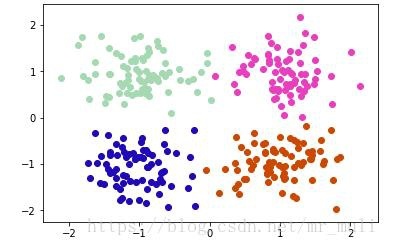Python implements mean-shift clustering algorithm
The examples in this article share the specific code of python to implement the mean-shift clustering algorithm for your reference. The specific content is as follows
1、 Create a new MeanShift.py file
import numpy as np
# Define a preset threshold
STOP_THRESHOLD =1e-4
CLUSTER_THRESHOLD =1e-1
# Define the measurement function
def distance(a, b):return np.linalg.norm(np.array(a)- np.array(b))
# Define Gaussian kernel function
def gaussian_kernel(distance, bandwidth):return(1/(bandwidth * np.sqrt(2* np.pi)))* np.exp(-0.5*((distance / bandwidth))**2)
# mean_shift class
classmean_shift(object):
def __init__(self, kernel=gaussian_kernel):
self.kernel = kernel
def fit(self, points, kernel_bandwidth):
shift_points = np.array(points)
shifting =[True]* points.shape[0]while True:
max_dist =0for i inrange(0,len(shift_points)):if not shifting[i]:continue
p_shift_init = shift_points[i].copy()
shift_points[i]= self._shift_point(shift_points[i], points, kernel_bandwidth)
dist =distance(shift_points[i], p_shift_init)
max_dist =max(max_dist, dist)
shifting[i]= dist STOP_THRESHOLD
if(max_dist < STOP_THRESHOLD):break
cluster_ids = self._cluster_points(shift_points.tolist())return shift_points, cluster_ids
def _shift_point(self, point, points, kernel_bandwidth):
shift_x =0.0
shift_y =0.0
scale =0.0for p in points:
dist =distance(point, p)
weight = self.kernel(dist, kernel_bandwidth)
shift_x += p[0]* weight
shift_y += p[1]* weight
scale += weight
shift_x = shift_x / scale
shift_y = shift_y / scale
return[shift_x, shift_y]
def _cluster_points(self, points):
cluster_ids =[]
cluster_idx =0
cluster_centers =[]for i, point inenumerate(points):if(len(cluster_ids)==0):
cluster_ids.append(cluster_idx)
cluster_centers.append(point)
cluster_idx +=1else:for center in cluster_centers:
dist =distance(point, center)if(dist < CLUSTER_THRESHOLD):
cluster_ids.append(cluster_centers.index(center))if(len(cluster_ids)< i +1):
cluster_ids.append(cluster_idx)
cluster_centers.append(point)
cluster_idx +=1return cluster_ids
2、 Call the above py file
# - *- coding: utf-8-*-"""
Created on Tue Oct 0911:02:082018
@ author: muli
"""
from sklearn.datasets.samples_generator import make_blobs
import matplotlib.pyplot as plt
import random
import numpy as np
import MeanShift
def colors(n):
ret =[]for i inrange(n):
ret.append((random.uniform(0,1), random.uniform(0,1), random.uniform(0,1)))return ret
def main():
centers =[[-1,-1],[-1,1],[1,-1],[1,1]]
X, _ =make_blobs(n_samples=300, centers=centers, cluster_std=0.4)
mean_shifter = MeanShift.mean_shift()
_, mean_shift_result = mean_shifter.fit(X, kernel_bandwidth=0.5)
np.set_printoptions(precision=3)print('input: {}'.format(X))print('assined clusters: {}'.format(mean_shift_result))
color =colors(np.unique(mean_shift_result).size)for i inrange(len(mean_shift_result)):
plt.scatter(X[i,0], X[i,1], color = color[mean_shift_result[i]])
plt.show()if __name__ =='__main__':main()
The result is shown in the figure:

Reference link
The above is the whole content of this article, I hope it will be helpful to everyone's study.
Recommended Posts